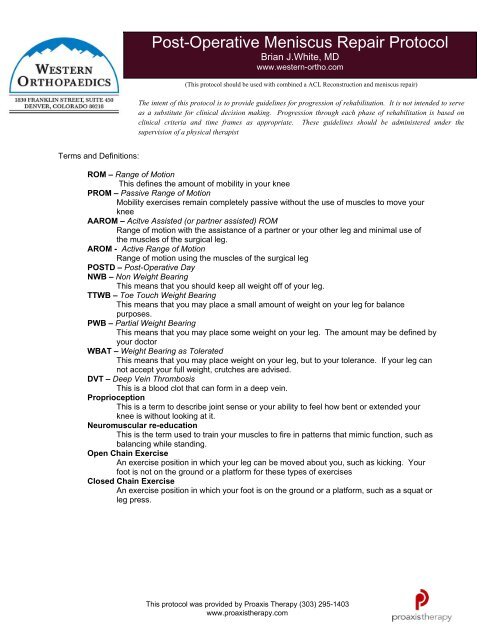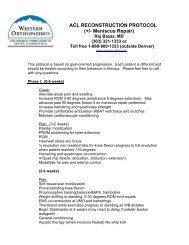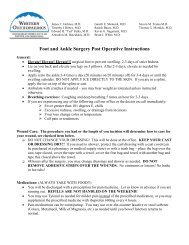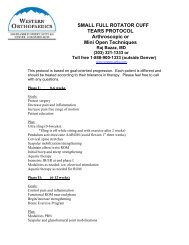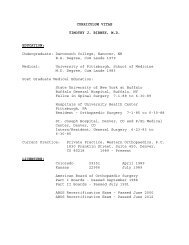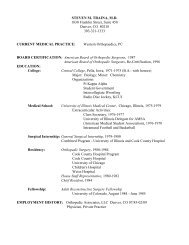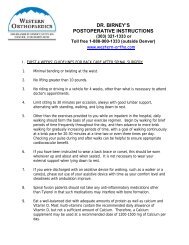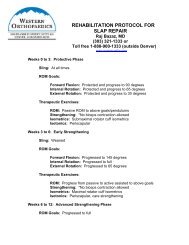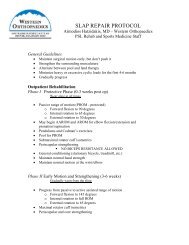Post-Operative Meniscus Repair Protocol
Post-Operative Meniscus Repair Protocol
Post-Operative Meniscus Repair Protocol
Create successful ePaper yourself
Turn your PDF publications into a flip-book with our unique Google optimized e-Paper software.
Range of Motion – (note: ROM may be limited to 90º to protect the meniscusrepair)• Passive Range of Motiono Wall Slideso Seated Passive flexion-extensiono Table slideso Low Load Prolonged Stretches• Coffee table hang – for extension• Seated prolonged flexion hold (begin when full flexion isallowed)• Active Assist Rang of Motion (as allowed with ROM restrictions)o Stationary Bike without resistance• Patellar mobilizations• Manual therapy as indicated• Quad and Hamstring stretching as indicated• Hydrotherapyo Aquajogging and ROM exercises are permitted when incisionshave healed (~2weeks)Gait (walking)• Crutches may be indicated for the first 4-6 weeks to protect therepaired meniscus keep. This will help to reduce swelling and pain• NWB, PWB or TTWB may be prescribed by the surgeon depending onthe magnitude of meniscus repair, ACL revisions, ACL graft types orother injuries to the knee (tibia plateau fractures, for example)• Weaning from crutcheso Begin with weight shifting exerciseso Begin walking with more weight while using crutcheso Single crutch walking• This will reduce weight on your surgical leg by 25%• Be sure to place the crutch under the opposite armo Walk small distanced in home without crutches and takecrutches with you for longer distances• Hydrotherapy – water walkingo Walk in water at shoulder levelo Advance to walking at waist levelStrength• Quadriceps (Quads)o Quad Sets – isometric quad contractions• NMES (Neuromuscular Electric Stimulation) as indicated• Biofeedback as indicatedo Straight Leg Raising (SLR)• Hamstring Sets – Isometric Hamstring contractions• Calf Muscles – Heel-Toe Raises• Open-Chain hip exerciseso Abductiono AdductionThis protocol was provided by Proaxis Therapy (303) 295-1403www.proaxistherapy.com
Proprioception and Neuromuscular Re-education• Begin open chain proprioception exercises• Light co-contraction exercises• Light closed chain stability balance exercises (if weight bearing statuspermits)Phase 2 – Initial Strengthening - (<strong>Post</strong>-<strong>Operative</strong> weeks 5-12)Criteria to advancement to Phase 2• Minimal Swelling• Full passive extension• Full active extension• 90º passive flexionGoals• Eliminate Swelling• Restore Full active and passive ROM• Increase leg strength to allow for:o Walking long distanceso Stair ascending/descendingo Double knee bend without compensationso Singe knee bend to 70º without compensationsSwelling• Continue PRICE’ing with residual swelling• Modalities as indicated - Ultrasound, Electric Stimulation,IontophoresesRange of Motion (emphasis should initially be placed on restoring normal ROMbefore advancing to strengthening exercises)Wall SlidesSeated flexion/extensionLow resistance stationary bikingQuad and Hamstring stretching as indicatedPatellar mobilizations and manual therapy as indicatedLow Load Prolonged Stretcheso Coffee table hang – for extensiono Seated prolonged flexion holdStrength• Closed Chain Strength progression (Glutes and Quads)o Leg press with light weight and high repetitionso Mini Squats, 1/3 knee bendso Double knee bends to 90ºo Single Knee Bends – advance to 70 as toleratedThis protocol was provided by Proaxis Therapy (303) 295-1403www.proaxistherapy.com
o Light plyometrics on shuttle• Hamstring Specific Exerciseso Carpet Dragso Hamstring Curlso Physio-ball bridging knee bends• Calf Muscles• Hip exerciseso Side Steps with thera-bando Adduction• Cardioo Begin stationary bike with resistanceo Eliptical trainero Treadmill walking with inclineo Swimming (breast stroke is not recommended)Proprioception, Balance and Neuromuscular Re-education• Begin double leg stability exercises on balance board• Single leg balance on stable/semi unstable (foam) surface• Single leg balance on balance board• Variations of balance exercises with perturbation training• Variations of balance exercises during alternate activity (i.e. balltossingPhase 3 – Advanced Strengthening (post-operative weeks 10- sport test completion)Criteria for advancement to Phase 3No residual swelling presentFull Active and Passive ROMAscending and Descending stairs with involved leg without pain orcompensationAt least 1 minute of double knee bends without compensationsSingle knee bends to 70º flexion without compensationsPersons who do not participate in higher level activities may not need to advance to phase 3. Activitiesthat require advanced strengthening include: running, bounding sports, cutting sports and jumping sports,such as, skiing and snowboarding, golf, basketball, tennis and racquetball, soccer, football and hockey.Goals:Restore multi-directional strengthRestore ability to absorb impact on leg (plyometric strength)Pass sport testThis protocol was provided by Proaxis Therapy (303) 295-1403www.proaxistherapy.com
Strength, Agility, Balance and Stability TrainingIncrease time on double knee bends with resistanceIncrease time on single knee bends. Add resistance as toleratedForward backward jog exercises with sport cordLateral Agility exerciseJump-land trainingAdvanced perturbation, balance and stability exercisesContinue with cardio trainingPhase 4 – Return to Sport (passing of sport test – 6 months)Criterion for advancement to phase 4Pass sport testStrength and Agility• Agility Drillso Chop-Downso Back Pedalso W-Cutso Z-Cutso Cariocaso Cutting Drillso Sport Specific Drills• Adjust Strength and Cardio Regimen to demands of sport• Team Training Progressiono Begin training with team at 50% participation levelo Advance to 100% participationo Athlete may begin competition at 6 months post-op, or at thediscretion of surgeon and physical therapist• Begin following sports at specified times or according to the discretionof surgeon and/or physical therapisto Running – 4-5 monthso Mountain biking 4-5 monthso Golf – 5 monthso Soccer, football, tennis – 6 monthso Skiing and snowboarding – 6 monthsThis protocol was provided by Proaxis Therapy (303) 295-1403www.proaxistherapy.com


